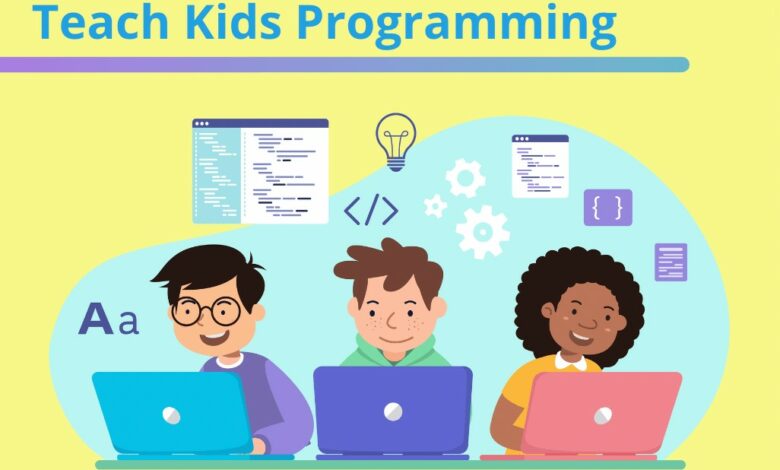
Table of Content
In today’s digitally-driven world, the ability to code is becoming an increasingly valuable skill. “The ability to code and understand the power of computing is crucial to success in today’s hyper-connected world.” – Ginni Rometty, Former CEO of IBM Recognizing this, many parents and educators are eager to introduce programming to children and teenagers at an early age. However, the prospect of teaching coding to kids and teens can seem daunting. Where should you begin? How can programming be made accessible and engaging for kids and teens?
This guide aims to answer these questions and provide actionable strategies for introducing programming to the next generation of innovators.
Understanding the Benefits of Teaching Programming to Kids & Teens
Before delving into the how-to’s, it’s essential to understand the numerous benefits of teaching programming to children and teenagers.
Critical Thinking and Problem-Solving Skills:
Programming challenges individuals to think logically, break down complex problems into manageable parts, and devise creative solutions.
Creativity and Innovation:
Coding fosters creativity by enabling individuals to bring their ideas to life through software development, game design, and digital art.
Future Career Opportunities:
In an increasingly technology-driven world, proficiency in programming opens doors to lucrative career opportunities in fields such as software engineering, data science, and artificial intelligence.
Digital Literacy:
Teaching coding equips kids and teens with essential digital literacy skills, empowering them to understand and navigate the digital landscape confidently.
Choosing the Right Programming Language and Tools
Selecting the appropriate programming language and tools is crucial when introducing programming to kids and teens. Consider the following factors:
Age and Developmental Stage:
The first step is to consider your child’s age. Younger children may benefit from visual programming languages like Scratch or Blockly, which utilize drag-and-drop interfaces and colorful blocks to create code. Older teens can explore text-based languages such as Python or JavaScript.
Interests and Goals:
Tailor the programming experience to the interests and aspirations of your child or teen. For example, those interested in game development may enjoy learning languages like C# with game development frameworks like Unity.
Accessibility and Support:
Choose languages and tools with ample learning resources, tutorials, and supportive communities. Online platforms like Code.org, CodeWizardsHQ, and Scratch offer beginner-friendly resources and classes for aspiring young programmers.
Making Programming Engaging and Interactive
To captivate the attention of kids and teens, programming activities should be engaging, interactive, and hands-on. Here are some effective strategies:
Gamification:
Incorporate elements of gamification into coding activities by setting challenges, awarding badges or points for accomplishments, and encouraging friendly competition.
Project-Based Learning:
Encourage kids and teens to work on real-world projects that align with their interests. Whether it’s creating a mobile app, designing a website, or programming a robot, project-based learning provides tangible goals and fosters a sense of accomplishment.
Collaborative Learning:
Foster a collaborative learning environment where kids and teens can work together, share ideas, and solve problems as a team. Pair programming, where two programmers work together at one computer, can be particularly beneficial.
Interactive Tutorials and Games:
Utilize interactive tutorials and educational games to introduce programming concepts in a fun and engaging manner. Platforms like CodeCombat and Codingame offer gamified coding challenges that make learning programming feel like play.
Effective Methods for Kids to Learn Programming
Introducing programming to kids can be approached in various ways, catering to different learning styles and interests. Here are some effective methods to introduce programming to kids:
Books and Interactive Storytelling:
There are numerous children’s books and storybooks that introduce coding concepts in a fun and engaging way. These books often feature characters navigating through coding adventures, solving puzzles, and learning programming concepts along the way. Examples include “Hello Ruby” by Linda Liukas and “How to Code a Sandcastle” by Josh Funk.
Online Courses and Tutorials:
Online platforms offer interactive courses and tutorials specifically designed for kids to learn programming at their own pace. Websites like Code.org, Khan Academy, and Scratch.mit.edu provide beginner-friendly resources, coding challenges, and interactive lessons that make learning programming accessible and enjoyable.
Coding Camps and Workshops:
Summer coding camps and workshops provide immersive learning experiences where kids can collaborate with peers, work on projects, and receive guidance from experienced instructors. These programs often offer hands-on activities, group projects, and coding challenges that encourage creativity and problem-solving skills.
Educational Apps and Games:
There is a wide range of educational apps and games that teach coding concepts through gameplay and interactive activities. Apps like ScratchJr, Tynker, and Lightbot offer intuitive interfaces and engaging challenges that introduce kids to programming fundamentals in a playful manner.
STEM Toys and Robotics Kits:
STEM toys and robotics kits provide hands-on learning experiences that combine programming with tangible, physical objects. Products like LEGO Mindstorms, Sphero, and Ozobot allow kids to build robots, program them using block-based coding languages, and explore concepts like sensors, motors, and algorithms.
School Curriculum Integration:
Many schools are integrating coding into their curriculum, offering coding classes, clubs, and extracurricular activities. These programs provide structured learning opportunities where kids can develop coding skills alongside their peers under the guidance of teachers who are trained in computer science education.
Parent-Led Activities and Projects:
Parents can introduce programming to kids through hands-on activities and projects at home. Websites like code.org/learn and Scratch.mit.edu provide free resources and tutorials that parents can use to facilitate coding activities and explore programming concepts together with their children.
Coding Competitions and Hackathons:
Participating in coding competitions and hackathons can inspire kids to apply their programming skills to real-world challenges and collaborate with peers to find innovative solutions. Events like CodeCombat and FIRST LEGO League offer opportunities for kids to showcase their coding abilities and engage in friendly competition.
Mentorship and Role Models:
Connecting kids with mentors and role models who work in the tech industry can inspire and motivate them to pursue coding. Mentorship programs, coding clubs, and meetups provide opportunities for kids to learn from experienced professionals, ask questions, and gain insights into potential career paths in technology.
Coding Toys and Gadgets:
Coding toys and gadgets, such as programmable robots, electronic building kits, and coding board games, offer hands-on learning experiences that blend play with programming. Products like LittleBits, Cubetto, and Botley provide opportunities for kids to experiment with coding concepts in a tangible and interactive way.
By leveraging these diverse methods, parents, educators, and mentors can introduce programming to kids in a way that aligns with their interests, learning preferences, and developmental stage, setting them on a path towards becoming confident and proficient coders in the future.
Encouraging Continued Learning and Exploration
Introducing programming to kids and teens is just the beginning of their coding journey. Encourage continued learning and exploration by:
Exposing Them to Diverse Technologies: Introduce kids and teens to a variety of programming languages, tools, and technologies to broaden their skill set and expand their horizons.
Encouraging Self-Directed Learning: Empower kids and teens to pursue their coding interests independently through online courses, tutorials, and coding challenges. Encourage them to explore new programming languages and projects that pique their curiosity.
Providing Mentorship and Support: Connect kids and teens with mentors, teachers, or peers who can provide guidance, support, and encouragement in their coding endeavors. Mentorship programs, coding clubs, and hackathons offer valuable opportunities for networking and collaboration.
Promoting Community Engagement: Encourage kids and teens to engage with the broader programming community through forums, meetups, and coding events. Participating in hackathons, coding competitions, and open-source projects can inspire creativity, foster collaboration, and provide valuable learning experiences.
By following these strategies and fostering a supportive learning environment, parents and educators can effectively introduce programming to kids and teens, paving the way for future innovation, creativity, and success in the digital age.
As young minds embark on their coding journey, they not only acquire valuable technical skills but also cultivate critical thinking, problem-solving, and resilience—attributes that will serve them well in all aspects of life. So let’s empower the next generation of innovators to code, create, and shape the future!




